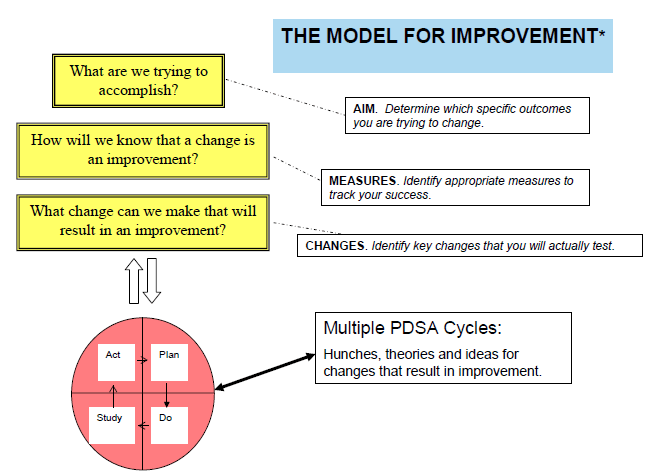Quality Improvement Tools Pdsa Soccer
. To learn what happens when we try to do something differently. There are 3 common reasons to use the PDSA cycle in an improvement effort:. To build knowledge to help answer any of the three questions in the Model for Improvement. To test a change. To implement a change.

Use the PDSA Cycle to build knowledge. Knowledge is gained through careful predictions about what will happen during testing and then comparing what actually happened. Most purposeful improvements will require multiple cycles to further build knowledge. It provides a structure for iterative testing of changes to improve quality of systems.
It is used to turn ideas into action and learn from those actions. When testing new ideas, it helps to build knowledge about the impact of a change in the system. (The Improvement Guide, 2nd Edition, 2009).


It is commonly used with a recording template:. to document the views/thoughts of the team prior to carrying out a test of change. to ensure that you have an accurate record of the complete process of Plan, Do, Study, Act. To share the learning derived from undertaking a test of change. Most improvement projects will involve several tests of a variety of change ideas. Each change idea may require several iterative PDSA cycles.
Each change you test should be recorded and filed for future reference/sharing.
Peyton Manning making play calls at the line is an example of PDSA. (USATSI)(or Act) is a simple cyclical continuous improvement tool that we all use every day but don’t often realize it. Properly applied, PDSA helps us properly define a problem and determine a potential solution, enable the solution, and see if that solution worked. On Sunday, we are going to see a fantastic demonstration of PDSA every time Peyton Manning comes to the line during the Super Bowl. Here’s how he demonstrates itin 25 seconds or less. Manning studies the defensive alignment and determines what adjustments to the play call, if any, need to be made.StudyManning surveys the defensive look – the defensive scheme, the number of linebackers vs. Secondary defenders, what defenders are in the game, who is moving and who is lined up against whom – and sends a pass catcher in motion to see how the defense adjusts.
Based on this information, Manning can tell if the play his offense is currently prepared to execute will be effective. His analysis will either confirm or reject the offense’s hypothesis that the play will be effective. Manning relays a change in the play call to the offense.Adjust or ActIf Manning still believes the play will be effective based on his analysis, he calls for the center to hike him the ball and the offense runs the play. His analysis indicated that the offense should act.If he doesn’t think the original play called will be effective, Manning will make an adjustment by “audible”-ing out of the play call. He will relay hand signals and words to the offense that indicates a different play to run (such as changing from a running play to a passing play).(And yes, “Omaha” means something – either as an indicator to the offense or something said to throw off the defense.)The offensive players will move to different places on the line as necessary to execute the new play call. Manning will re-survey the defense’s adjustments to the new play call, make his own adjustments to how he will execute the play himself (since he will have the ball on the center’s hike).
He calls for the center to hike the ball and the offense executes the new play.In 25 seconds Peyton Manning applies Plan-Do-Study-Adjust to the execution of an offensive play to put the Broncos in the best position to advance the ball and score. Because he and his team have been so effective with execution, he will do that about 70 times on Super Bowl Sunday.Some additional resources about PDSA:Do you like this post? Give Lean Blitz a follow and a like!and.
I really like that article, though I think that there are multiple control cycles are in place in this example. An inner (Peyton Manning running it) and an outer control loop: Play calling by the OC. Also I do believe that Manning’s football control cycle is more like Plan – Check – Adjust – Act – Analyze. But, well, this “check & adjust” thing went bust right on the first snap from scrimmage Sunday night.
Quality Improvement Pdsa
Anyhow, I learn from this story, that an experienced, weathered helmsman won’t stick to the original plan, and opts for plan B at his own expense, whenever he deems that it is the right thing to do. So, should we all be more like Peyton and change our play when circumstances advise to do so, even when “the game plan” tells us to stick to some sort of “standard procedure”? Hi Alexander –That’s a good question. I think part of being a good project manager/process owner/quarterback is knowing when to stay the course and when to make the adjustment. Not every quarterback in the NFL or college has the capability of making line changes. Peyton used this strategy to get to the Super Bowl, but there are 30 other NFL quarterbacks whose strategies were not as effective.Peyton doesn’t always change the play.
He studies a LOT of film and can observe and analyze things on a defense better than probably anybody. So much of what he does comes from experience, knowing how to study, knowing what to see. That’s why PDSA is not really Act or Adjust – it’s both. I don’t agree that it’s merely a Check – obviously there is so much study that goes on at the line and in the film room to readily predict what the defense will do.